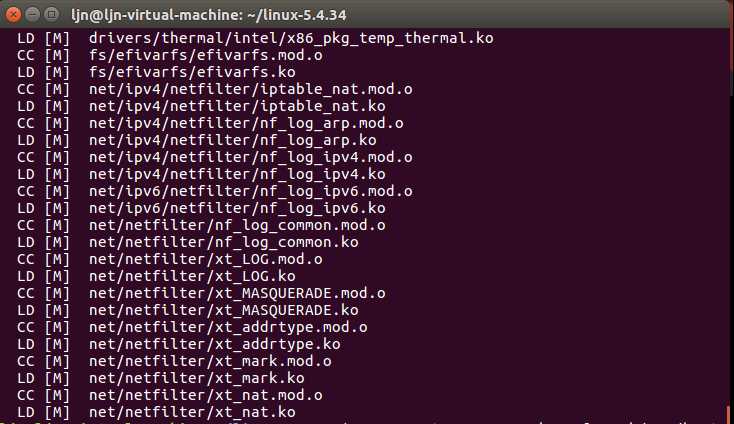实验要求
1、按照 https://github.com/mengning/mykernel 的说明配置mykernel 2.0,熟悉Linux内核的编译;
2、基于mykernel 2.0编写一个操作系统内核,参照 https://github.com/mengning/mykernel 提供的范例代码;
3、简要分析操作系统内核核心功能及运行工作机制。
实验环境及配置
VMware® Workstation 15 Pro
Ubuntu 16.04.3 LTS
一、配置 mykernel 2.0
1、配置mykernel 2.0的开发环境
在Linux终端中依次输入以下命令:
wget https://raw.github.com/mengning/mykernel/master/mykernel-2.0_for_linux-5.4.34.patch sudo apt install axel axel -n 20 https://mirrors.edge.kernel.org/pub/linux/kernel/v5.x/linux-5.4.34.tar.xz xz -d linux-5.4.34.tar.xz tar -xvf linux-5.4.34.tar cd linux-5.4.34 patch -p1 < ../mykernel-2.0_for_linux-5.4.34.patch sudo apt install build-essential gcc-multilib libncurses5-dev bison flex libssl-dev libelf-dev sudo apt install qemu
命令、工具解释分析如下:
(1)wget
非交互式网络文件下载工具,用于下载软件或从远程服务器恢复备份到本地服务器。
此处从指定github网站上下载 mykernel-2.0_for_linux-5.4.34.patch到本地。
(2)axel
多线程下载工具,可以进行批量下载。
第2条命令是安装axel工具,第3条命令是打开20个连接下载linux-5.4.34.tar.xz到本地。
(3)xz
xz命令用于解压“.xz”文件。
此处观察到linux-5.4.34.tar.xz,因此使用xz命令将其解压到当前文件夹,得到linux-5.4.34.tar。
(4)tar
tar命令用于将打包后的文件解包。
对linux-5.4.31.tar解包后,得到linux-5.4.34文件夹。
进入到该文件夹中,方便进入后续操作。
(5)patch
patch命令用于修补文件,让用户利用修补文件的方式进行原始文件的修改、更新等。
因此第7条命令是对第一步下载好的mykernel-2.0_for_linux-5.4.34.patch文件进行更新。
(6)build-essential
build-essential是一个包,里面开发包含很多开发必要的软件包。
第8条命令是安装保证可以对mykernel 2.0的运行和操作所必要的包。
(7)qemu
qemu是一个本身是一个强大的虚拟机,相当于是一个沙盒环境,可以运行自己编译的内核。
第9条命令为安装该qemu工具。
2、对内核进行编译
在Linux终端中依次输入以下命令:
make defconfig make -j$(nproc)
命令解释分析如下:
(1)make defconfig
生成内核编译,按照默认的i386_defconfig生成.config。
(2)make -j$(nproc)
make命令后的-j参数可以加快编译速度。
编译完成后,结果如下:

3、启动qemu,在窗口中观察执行结果
在linux终端输入如下命令:
qemu-system-x86_64 -kernel arch/x86/boot/bzImage
执行结果如下:

qemu窗口输出的内容是由 linux-5.3.34内核源代码根目录下mykernel目录中的mymain.c和myinterrupt.c决定的。
代码分析如下:
(1)mymain.c
主要代码如下:
void __init my_start_kernel(void) { int i = 0; while(1) { i++; if(i%100000 == 0) pr_notice("my_start_kernel here %d ",i); } }
当我们提供了一个虚拟的CPU执行C代码的上下文环境时,mymain.c中的代码就在不停的执行,即是不停地输出“my_start_kernel here i”。
(2)myinterrupt.c
主要代码如下:
/* * Called by timer interrupt. */ void my_timer_handler(void) { pr_notice(" >>>>>>>>>>>>>>>>>my_timer_handler here<<<<<<<<<<<<<<<<<< "); }
同时我们也提供了一个中断处理程序的上下文环境,周期性地产生时钟中断信号,触发了myinterrupt.c中代码的执行,即不停的输出“my_time_handler here"。
二、基于 mykernel 2.0 编写一个操作系统内核——进程切换的实现
代码来自:https://github.com/mengning/mykernel
1、定义进程控制块(mypcb.h)
在linux-5.4.34/mykernel目录中新增一个名为 mypcb.h 头文件,用于定义进程控制块(Processing Control Block,PCB)。
进程控制块主要表示进程状态,操作系统根据PCB来对并发执行的进程进行控制和管理,PCB包含的信息主要包括:
- 进程id:用于区别进程
- 进程的状态:就绪、运行、挂起、停止
- 进程切换时需要保存和恢复的一些CPU寄存器
- 描述虚拟地址空间的信息:主要是描述了虚拟地址和物理地址的对应关系
- 当前工作目录
- umask掩码:保护文件创建和修改的权限
- ……
代码如下:
#define MAX_TASK_NUM 4 #define KERNEL_STACK_SIZE 1024*2 /* CPU-specific state of this task */ struct Thread { unsigned long ip; unsigned long sp; }; typedef struct PCB{ int pid; volatile long state; /* -1 unrunnable, 0 runnable, >0 stopped */ unsigned long stack[KERNEL_STACK_SIZE]; /* CPU-specific state of this task */ struct Thread thread; unsigned long task_entry; struct PCB *next; }tPCB; void my_schedule(void);
代码分析如下:
结构体PCB定义了进程控制块中的各个信息:
| 变量名 | 含义 | 解释 |
| pid | 进程id | 用于区分进程 |
| state | 进程状态 |
此处定义了三种状态,分别用-1、0、>0来表示 初始化值为-1,当被调度运行时,变为0,当被阻塞时,变为>0。 |
| stack[] | 进程使用的堆栈 | |
| thread | 当前正在执行的线程信息 | |
| task_entry | 进程入口函数 | |
| next | 指向下一个进程PCB的指针 | 所有进程的PCB以链表的形式存储 |
结构体Thread用于存储函数入口指针ip和栈顶指针sp。
函数my_schedule(void)是一个进程调度函数。
2、修改mymain.c
mymain.c是mykernel内核代码的入口,负责初始化内核的各个组成部分。
代码如下:
#include <linux/types.h> #include <linux/string.h> #include <linux/ctype.h> #include <linux/tty.h> #include <linux/vmalloc.h> #include "mypcb.h" tPCB task[MAX_TASK_NUM]; tPCB * my_current_task = NULL; volatile int my_need_sched = 0; void my_process(void); void __init my_start_kernel(void) { int pid = 0; int i; /* Initialize process 0*/ task[pid].pid = pid; task[pid].state = 0;/* -1 unrunnable, 0 runnable, >0 stopped */ task[pid].task_entry = task[pid].thread.ip = (unsigned long)my_process; task[pid].thread.sp = (unsigned long)&task[pid].stack[KERNEL_STACK_SIZE-1]; task[pid].next = &task[pid]; /*fork more process */ for(i=1;i<MAX_TASK_NUM;i++) { memcpy(&task[i],&task[0],sizeof(tPCB)); task[i].pid = i; task[i].thread.sp = (unsigned long)(&task[i].stack[KERNEL_STACK_SIZE-1]); task[i].next = task[i-1].next; task[i-1].next = &task[i]; } /* start process 0 by task[0] */ pid = 0; my_current_task = &task[pid]; asm volatile( "movq %1,%%rsp " /* set task[pid].thread.sp to rsp */ "pushq %1 " /* push rbp */ "pushq %0 " /* push task[pid].thread.ip */ "ret " /* pop task[pid].thread.ip to rip */ : : "c" (task[pid].thread.ip),"d" (task[pid].thread.sp) /* input c or d mean %ecx/%edx*/ ); } int i = 0; void my_process(void) { while(1) { i++; if(i%10000000 == 0) { printk(KERN_NOTICE "this is process %d - ",my_current_task->pid); if(my_need_sched == 1) { my_need_sched = 0; my_schedule(); } printk(KERN_NOTICE "this is process %d + ",my_current_task->pid); } } }
代码分析如下:
__init my_start_kernel(void):初始化多个进程并且启动0号进程
myprocess(void):模拟进程执行过程,此处采用的是时间片轮转方法进行进程的调度,即进程运行完一个时间片后主动让出CPU。
3、修改myingerrupt.c
mykernel提供了时钟中断机制,即通过周期性地执行my_time_handler函数来中断处理程序,因此我们就对该函数进行修改来记录时间片,当时间片消耗完时就进行进程的切换。
代码如下:
#include <linux/types.h> #include <linux/string.h> #include <linux/ctype.h> #include <linux/tty.h> #include <linux/vmalloc.h> #include "mypcb.h" extern tPCB task[MAX_TASK_NUM]; extern tPCB * my_current_task; extern volatile int my_need_sched; volatile int time_count = 0; /* * Called by timer interrupt. * it runs in the name of current running process, * so it use kernel stack of current running process */ void my_timer_handler(void) { if(time_count%1000 == 0 && my_need_sched != 1) { printk(KERN_NOTICE ">>>my_timer_handler here<<< "); my_need_sched = 1; } time_count ++ ; return; } void my_schedule(void) { tPCB * next; tPCB * prev; if(my_current_task == NULL || my_current_task->next == NULL) { return; } printk(KERN_NOTICE ">>>my_schedule<<< "); /* schedule */ next = my_current_task->next; prev = my_current_task; if(next->state == 0)/* -1 unrunnable, 0 runnable, >0 stopped */ { my_current_task = next; printk(KERN_NOTICE ">>>switch %d to %d<<< ",prev->pid,next->pid); /* switch to next process */ asm volatile( "pushq %%rbp " /* save rbp of prev */ "movq %%rsp,%0 " /* save rsp of prev */ "movq %2,%%rsp " /* restore rsp of next */ "movq $1f,%1 " /* save rip of prev */ "pushq %3 " "ret " /* restore rip of next */ "1: " /* next process start here */ "popq %%rbp " : "=m" (prev->thread.sp),"=m" (prev->thread.ip) : "m" (next->thread.sp),"m" (next->thread.ip) ); } return; }
代码分析如下:
my_schedule(void)函数:主要进行进程的切换。
4、执行结果
执行以下代码重新编译linux内核,并启动qemu来展示修改后代码的执行结果:
make defconfig make -j$(nproc) qemu-system-x86_64 -kernel arch/x86/boot/bzImage
执行结果如下所示:

process0 - process3 分别进行切换。
三、操作系统内核核心功能及工作机制
1、操作系统内核核心功能
内核是操作系统的核心部分,通常运行进程,并提供进程间的通信,主要管理系统的进程、内存、设备驱动程序、文件和网络系统。
2、内核工作机制
中断和系统调用
四、实验心得体会
通过本次实验,我了解了计算机系统的基本工作原理,对操作系统的内核有了更加深入的认识,对进程上下文的切换原理和实现代码也有了一定的了解,为之后的Linux操作系统的学习也打下了一定的基础。